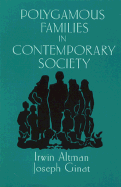Book contents
- Frontmatter
- Contents
- Foreword
- Preface and acknowledgments
- 1 Introduction
- Historical background
- Early stages of relationships
- Home environments of plural families
- Managing everyday life
- Social-emotional and family relationships
- Appendix A Methodology and procedure
- Appendix B Demographics of Mormon polygyny
- Notes
- References
- Index
Appendix A - Methodology and procedure
Published online by Cambridge University Press: 05 May 2010
- Frontmatter
- Contents
- Foreword
- Preface and acknowledgments
- 1 Introduction
- Historical background
- Early stages of relationships
- Home environments of plural families
- Managing everyday life
- Social-emotional and family relationships
- Appendix A Methodology and procedure
- Appendix B Demographics of Mormon polygyny
- Notes
- References
- Index
Summary
We obtained most of the information for this project over a five-year period, from 1987 to 1992, with some supplementary interviews and observations done up to 1994. However, the foundation for the research was established in the early 1970s, when Joseph Ginat was completing graduate studies in anthropology at the University of Utah. Beginning then, and up to the present, Ginat maintained relationships with members of both fundamentalist groups that are the focus of the present book. He also completed a research project in a fundamentalist community (Parker, Ginat, and Smith, 1975). Ginat has visited the urban and rural communities regularly since the 1970s, consulting with their leaders and members on biblical, archeological, and religious history; visiting and living on occasion in the homes of community members; attending and speaking in church and other meetings; hosting leaders and members in his home in Israel; and taking delegations on tours of holy sites in Israel. Given his extensive knowledge of biblical history, theology, and archeology and the fact that he is not an American but an Israeli (and one who was descended from the biblical tribe of Levi – spiritual leaders of biblical times), Ginat has been readily accepted by the fundamentalist communities.
Our collaboration began when Irwin and Gloria Altman visited Israel in 1986 to participate in professional meetings. Joseph and Dalia Ginat hosted the Altmans and, after two weeks of renewing an earlier casual acquaintanceship, we decided to fuse our interests in close relationships, family structure, environment and behavior, and polygyny, and crafted the present project.
- Type
- Chapter
- Information
- Polygamous Families in Contemporary Society , pp. 447 - 459Publisher: Cambridge University PressPrint publication year: 1996

